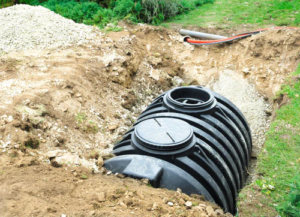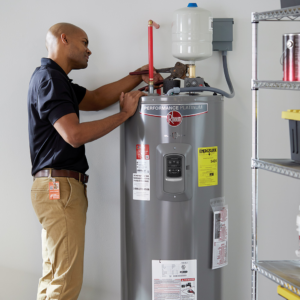Everything that goes down your toilets, sinks, bathtub and washing machine drains into a septic tank. The solid waste sinks to the bottom, forming a layer known as sludge. The lighter waste, such as fats, oils and greases, floats to the top.
Bacteria break down the sludge. The wastewater then leaves the septic tank through a pipe into the absorption field, or drain field. Contact Septic Tank Armadale now!

A septic tank is a buried, water-tight container that collects wastewater from a home. It holds the waste long enough for bacteria to break down solid waste. The resulting liquid wastewater is called effluent. It leaves the septic tank through a drain field or sand mound. If the septic tank is not kept up, sewage can back up into household drains.
As the wastewater travels through the absorption field, soil layers filter and digest it. When the effluent reaches groundwater, it is fully treated. However, if the tank is too full, it can clog the pipes leading to and from the house, and sewage may enter the environment.
When a septic tank is full, it will need to be pumped. Signs of a full tank include slow drains and puddles around the septic tank or house. A septic tank should be pumped every three to five years depending on the size of the household and how many people live in it.
As solids settle to the bottom of the septic tank, they form a layer known as sludge. This layer is dense and is made up of dirt, grit, bones, unconsumed food particles, and other solids. Underwater anaerobic bacteria slowly digest the sludge, producing gases as a byproduct. This creates a dark, slimy substance called sludge that needs to be removed at the same time as the tank is pumped.
Lightweight waste products such as grease and fats float to the top of the septic tank. These are separated from the sludge by an inlet baffle. When the septic tank is emptied, this clarified mixture of sludge and scum flows through the septic tank outlet to the drain field.
An effluent filter is often installed in the line between septic tank and drainfield to prevent solids from entering the septic tank outlet pipe and traveling to the drain field where they can clog pipes and shorten the drain field’s life. These filters can be expensive, but they are a necessary investment for homeowners with septic tanks. Alternatively, solids can be filtered out of the wastewater with a simple, low-cost gravity effluent filter that is cleaned at each tank pumping.
Sludge
A septic tank’s job is to collect waste and separate the solids from the liquids. Heavy solids like soil, grit, bones and unconsumed food particles sink to the bottom of the tank forming a thick layer known as sludge. Lighter wastes like oils and grease float to the top of the wastewater, creating a layer known as scum. Compartments and a T-shaped outlet prevent scum and sludge from leaving the septic tank with the liquid wastewater. The liquid wastewater, called effluent, exits the septic tank and flows into a drain field or leach field.
When the sludge and scum build up, it can cause problems for your home. For example, if the septic tank isn’t pumped often enough, the sludge and scum won’t be given enough time to separate from the water. If this happens, the septic tank will eventually fill up and the liquid wastewater will flow directly from the septic tank into the drain field, causing pathogenic bacteria to enter the environment.
The sludge also can clog pipes in the septic system and reduce the porosity of the drain field, causing it to fail. It can even contaminate drinking water. Finally, sludge can pollute local lakes and rivers with excessive amounts of phosphorus, which can promote prolific plant growth including algal blooms of potentially toxic cyanobacteria.
While it is true that septic tanks in urban areas produce more sewage sludge than rural ones, all septic systems generate some sludge. Since most rural residents use on-lot septic systems, they indirectly contribute to the generation of sewage sludge by having their septic tanks pumped and having their on-lot drainfields serviced.
In addition, if people flush non-biodegradable waste items down the toilet such as cigarette butts, paper towels, condoms, cotton swabs, dental floss and hair, they can also cause the septic tank to clog and fail. Having a professional septic contractor regularly inspect and service your septic system can help extend the amount of time between septic tank pumpings. You can also minimize the need for septic tank pumping by only putting biodegradable waste products like toilet paper, human waste and food down your toilet. Non-biodegradable waste items should be taken to a local hazardous waste facility for disposal.
Scum
Septic systems treat wastewater from the laundry, kitchen and bathrooms of homes where the municipal sewer system isn’t available. Wastewater contains germs and other pollutants that need to be separated from the water before it enters the environment.
When wastewater enters the septic tank, it undergoes a process called settling and flotation. Solid materials such as soil, grit, bones and unconsumed food particles sink to the bottom of the septic tank to form a layer known as sludge. Aerobic bacteria eat away at these solids to turn them into liquid waste. Fats, oils and greases float to the top of the wastewater and form a layer of scum. Bacteria in the septic tank digest these substances to produce a clear liquid that is known as effluent.
The septic tank is lined with concrete, fiberglass or polyethylene and buried underground. It has an inlet and an outlet baffle to prevent sludge from leaving the septic tank and entering the drain field. It also has a vent pipe that allows escaped gases to escape from the septic tank, preventing a buildup of pressure that could block or reverse the flow of wastewater into and out of the septic system.
Once the septic tank is full, the inlet and outlet baffles are closed. The effluent from the house flows through a pipe to the septic tank inlet. The septic tank inlet is usually a screen to filter out large debris from the wastewater.
The inlet baffle and outlet baffle prevent sludge and scum from exiting the septic tank and flowing into the drainfield. The septic tank also has a float that closes the outlet if the tank is full. The float is connected to an alarm that alerts the homeowner when the septic tank is filling or the pump is going out.
A septic system must be regularly inspected, cleaned and drained to avoid problems like leakage and groundwater contamination. Septic tanks are cheaper than municipal sewer costs, but they still require maintenance and can be expensive to repair or replace. The septic tank should be pumped every few years to keep it working properly. Biological additives can be added to the tank to accelerate the breakdown of organic wastes and reduce the frequency of pump outs.
Drain Field
A septic system’s drain field or leach field is designed to treat wastewater and filter contaminants out of groundwater. It is typically a series of perforated pipes in gravel-filled trenches in the soil. Wastewater from your home flows into the drain field through a distribution box. When the effluent enters the drain field, it is further filtered and neutralized as it seeps into the soil. The bacteria in the soil perform a final treatment. The drain field works in conjunction with the septic tank to help reduce pollution to the environment and to your property’s plumbing system.
When a septic tank is overloaded, the sludge layer in the bottom of the septic tank may not have time to separate from the scum layer on top. As a result, sewage may flow out of the septic tank into the drain field and backup the house’s drains. This is a serious health hazard as sewage contains disease-causing organisms that can be spread to people and pets when it comes into contact with them.
You can prevent septic tank and drain field problems by avoiding flushing chemicals, medications, harsh drain cleaners, or garbage disposals that contain large amounts of grease, oil, or cooking fats. You can also install a septic system with a pump, and make sure your septic tank is pumped regularly.
If you suspect a problem with your septic tank or drain field, it is important to call a professional right away for Drain Field Repair. It can be very dangerous to work on a septic system without the proper training and equipment. It is not uncommon for a septic tank or drain field to develop a problem when it has been neglected for too long.
Keeping up with regular maintenance on your septic tank, drain field, and all components of your septic system is critical to maintaining the efficiency and lifespan of your septic system. Contact the experts at Septic Solutions if you need to schedule a routine septic tank cleaning or have questions about the condition of your septic tank, septic tank pumping, or drain fields.
